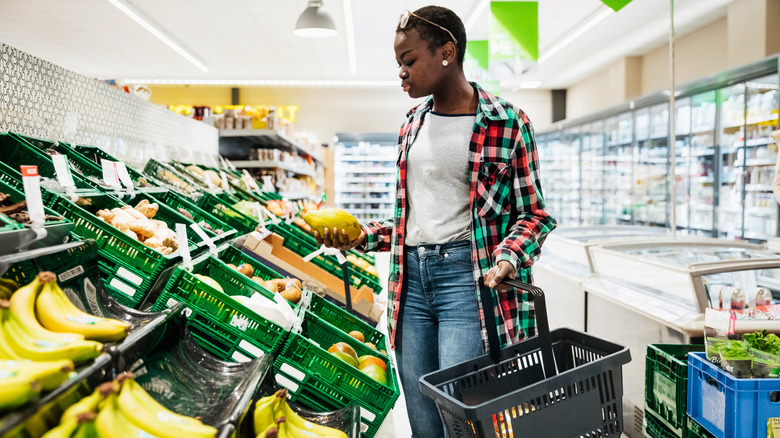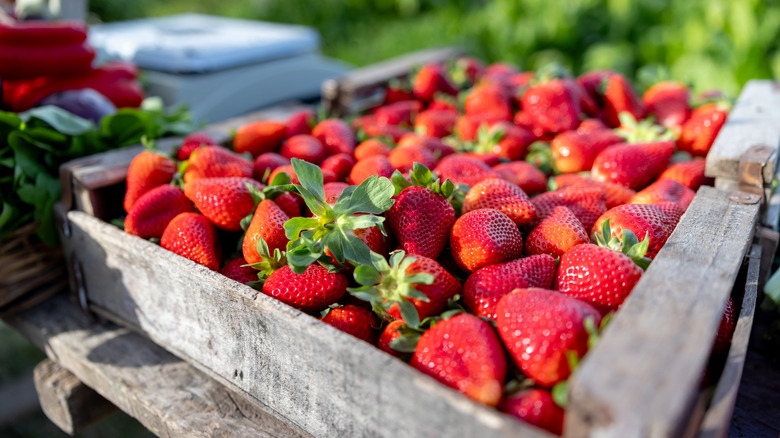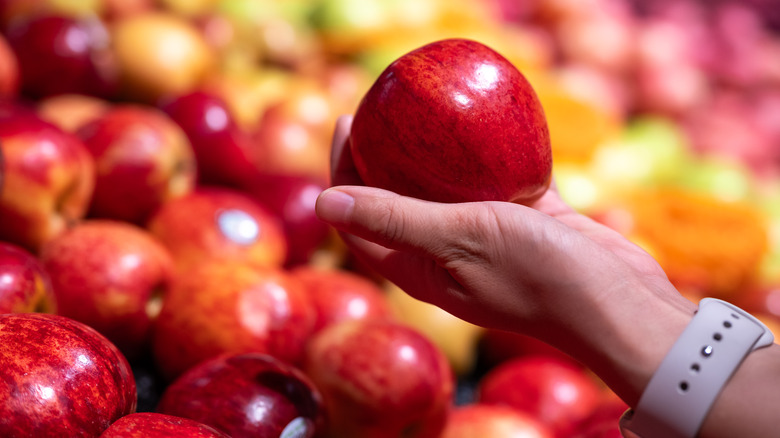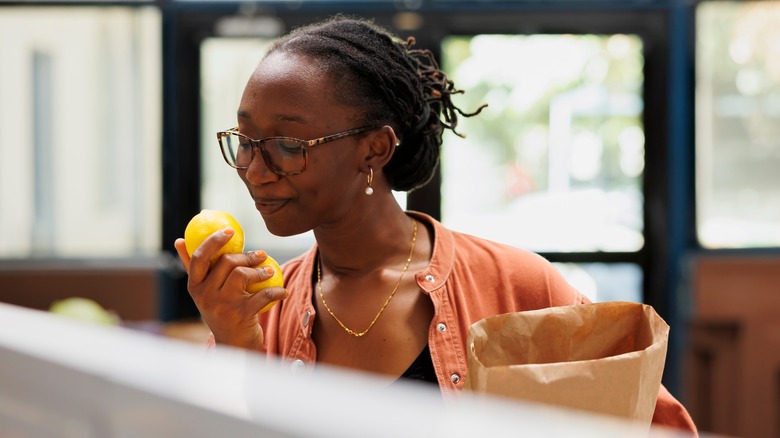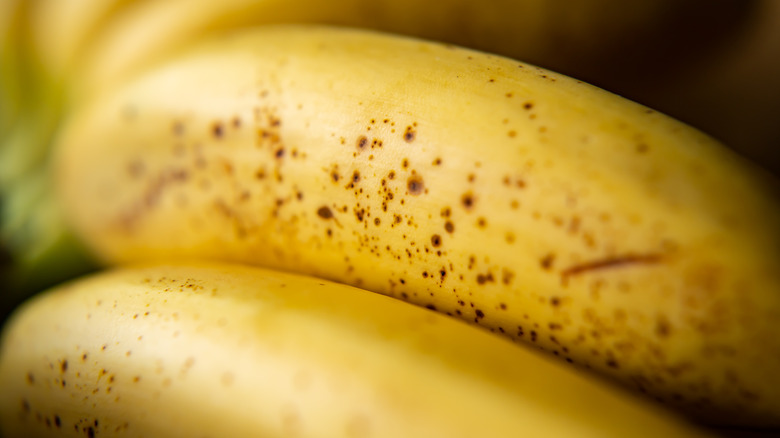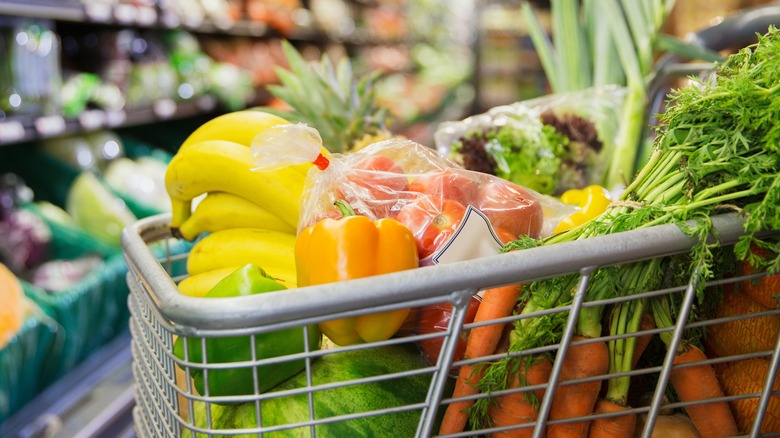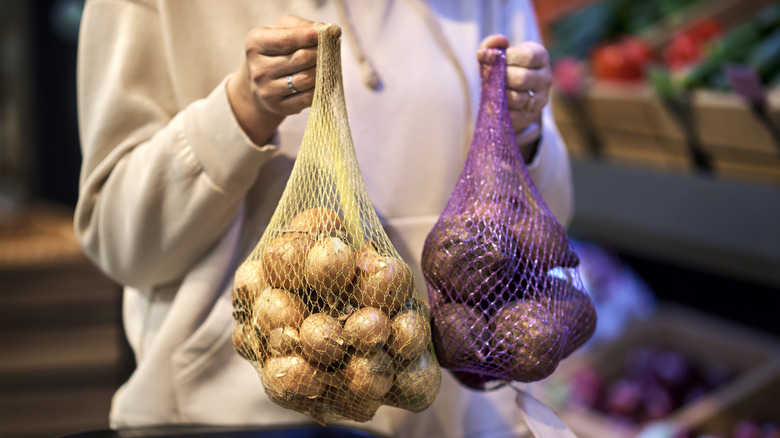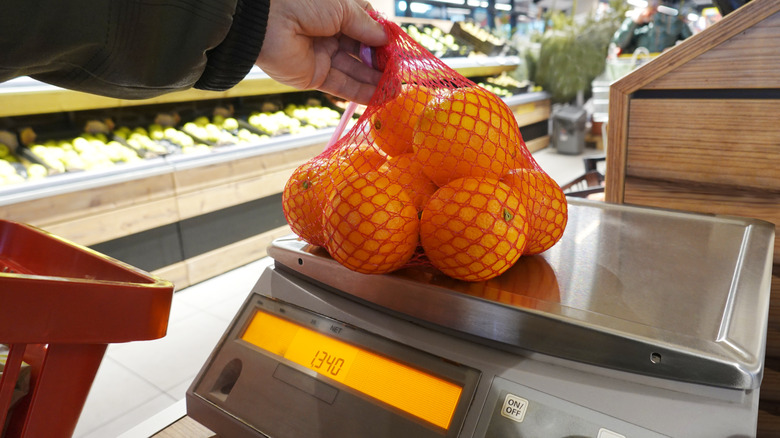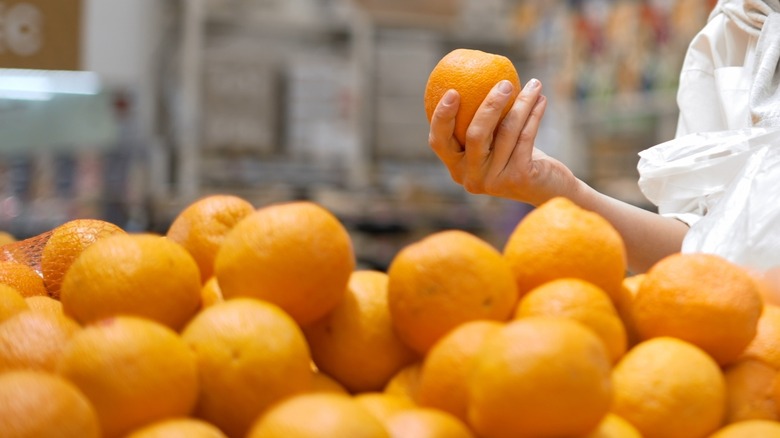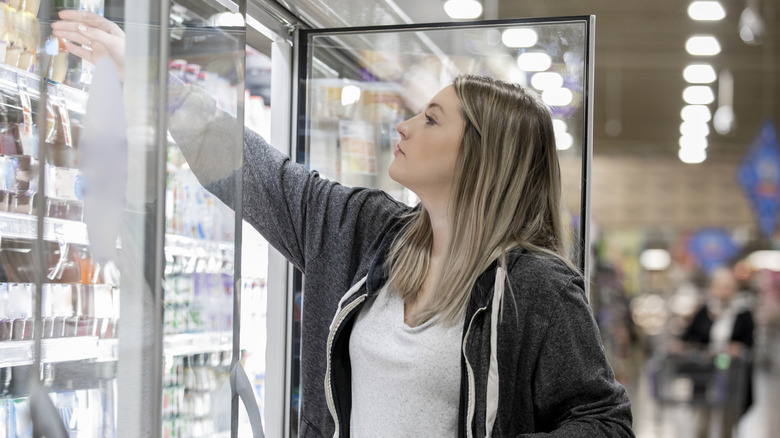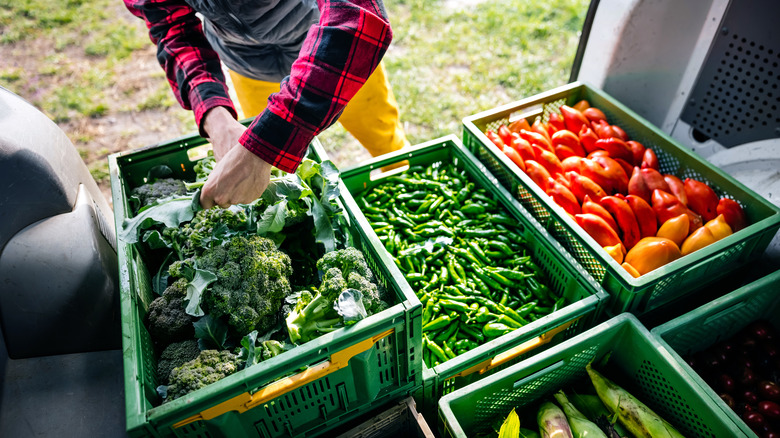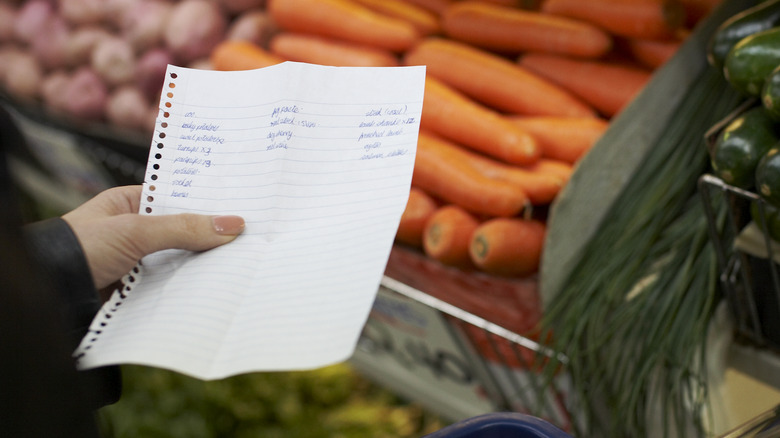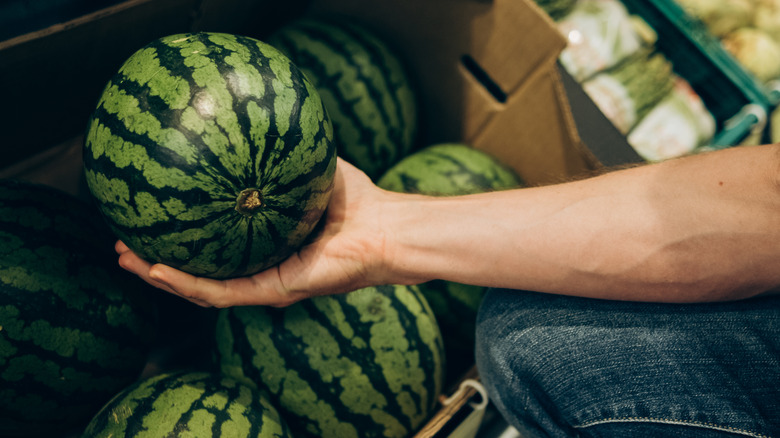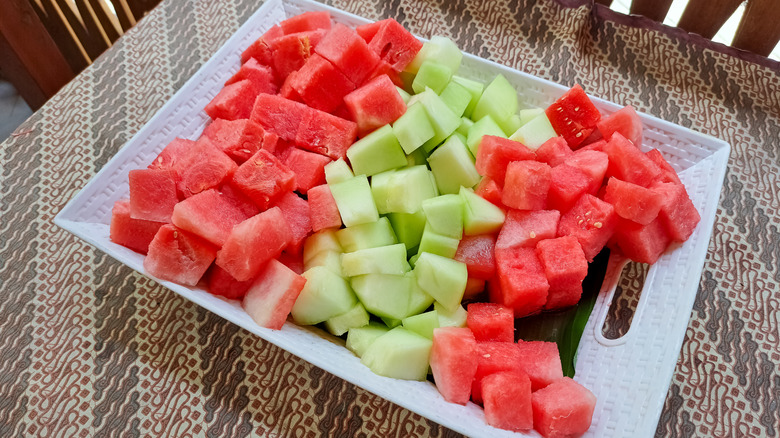Mistakes Everyone Makes When Buying Produce At The Grocery Store
Buying produce at the grocery store may seem like a mundane task, but what if we told you that you're doing it wrong? While everyone has a shopping system they tend to cling to, uninformed habits and practices may leave you with a grocery cart full of produce that's less than best. As you'll soon see, there are details worth paying attention to when shopping for produce that can help ensure you get the quality and flavor you're looking for. Additionally, by learning to shop produce using more effective techniques, you may find yourself saving money, and with a lot more fruits and vegetables to enjoy, too.
Sounds interesting? If so, stick around. In this post, we're revealing the common mistakes shoppers make when buying produce at the grocery store as well as tips and tricks to help you get the most out of your grocery shopping experience.
Not buying produce in season
If you aren't accustomed to buying produce in season, it might seem like a waste of time. After all, if the produce you see looks ripe and delicious, why not purchase it, right? Not exactly. Though your local grocer's produce may look the part, the truth is that buying fruits and veggies in season is far more advantageous. Generally speaking, produce purchased in season is fresher and tastier. It can also be grown locally, meaning it has less distance to travel before hitting store shelves. Because of its abundance and ideal growing conditions, seasonal fruits and veggies also tend to be cheaper.
Not sure when to purchase your favorite produce? Try researching fruits and veggies harvested in the current season. These spring fruits and vegetables or these fruits that are best in summer months are great seasonal options. Other fruits and veggies, like pumpkin, pears, and grapes, taste fantastic in the fall, and citrus is the name of the game in winter. Once you start purchasing in-season produce, you likely won't want it any other way.
Assuming the sheen on produce is always natural
One of the mistakes everyone makes when buying produce at the grocery store is assuming that the produce is naturally as glossy as it appears. While not true for all fruits and veggies, some types of produce are polished with food-grade wax before getting placed on display. In these instances, both paraffin and carnauba waxes are used to make produce look better and last longer. Even so, the FDA requires that all bagged produce with wax applied come labeled. Thus, if potential wax products covering your fruit and veggies bother you, be sure to keep an eye out for statements indicating its use on produce packaging.
So, which fruits and vegetables are most susceptible to wax coatings? Apples and oranges commonly come coated, as do peaches and nectarines. If you must buy wax-coated produce but don't care to ingest it, try soaking your fruits and vegetables in a mixture of water and vinegar before eating. This mixture disintegrates the wax while leaving behind produce that is fresh and clean. Just be sure to give it a rinse before eating; neglecting to do so may leave you with a puckered mouth full of vinegar.
Not sniffing your produce for signs of ripeness
Sniffing your produce before purchasing can sometimes help you determine which are ripe and ready to eat. There are about 14 fruits and vegetables you should smell before you buy, though we're sure there are others. Cantaloupe, for example, will have a very sweet smell to it when it is at its prime, particularly at its stem. The same is true of pineapple. Other fruits and veggies that produce informative aromas include peppers, tomatoes, oranges, and strawberries.
While smelling your produce can be a clue as to whether or not the produce is ready to enjoy, it can also be a sign that something's off. Any unusually sour, musky, or rancid smells can imply that your produce has gone awry. Onions, for example, shouldn't necessarily smell very oniony before you cut into them, but instead should smell mildly sweet. Any strong or sour odors could indicate that your onion is overripe. Yes, you'll look a little funny compulsively sniffing your produce in grocery store aisles but enjoying ripe and delicious fruits and vegetables makes it all worth it.
Bypassing discount produce
Bruised and battered produce might not seem appealing at first glance, but there are a variety of ways to use fruits and veggies that are past their prime. Though discount produce may feature soft spots, brown specks, and other signs of overripeness, using them in specific recipes won't only put them to good use but may even intensify the flavor of the recipe more than fresher produce.
Take overripe bananas, for example. Though not as enjoyable when eaten solo, they taste incredible when added to certain recipes like banana smoothies and banana bread. Because overripe bananas are much sweeter than their fresher counterparts, they work as a natural sweetener that can sometimes reduce or even eliminate the need for added sugar. Other types of discounted produce, like apples, can be used in apple pie, to make applesauce, or even to reuse the apple peels to make a smoothie. Peppers are another type of produce we often see marked down; dice these up and add them to stir fry or toss them in chili, and no one will be able to discern the difference.
Buying more produce than you (actually) need
Unless you eat a ton of produce daily, buying too many fruits and vegetables may lead to waste by the end of the week. While purchasing produce in bulk can be a great way to save money, overdoing it may lead to more headaches than necessary.
To prevent spoilage, try to only buy the amount of produce you think you'll realistically eat in the week. If you want to purchase larger quantities of fruits and vegetables to save more money, always have a plan for how to store your leftovers. Freezing your produce, for example, is a great option, although some fruits and vegetables freeze better than others. Strawberries are always a good choice, especially when they are in season, for use in smoothies or strawberry lemonade pie (yes, it's a thing). Other easy-to-freeze summer fruits and vegetables include stone fruit, melons, corn, green beans, and more.
If you aren't crazy about the idea of freezing your produce, consider interesting ways to use up your fruits and veggies, instead. Chicken salad, fruit bowls, soups, and hearty stews are just a handful of splendid alternatives for getting rid of produce in the most delicious way.
Purchasing individual produce items rather than in a bag
Though it may not be true in every instance, purchasing produce in a bag can mean getting individual fruits and vegetables for less. We tested this theory at our local Walmart, comparing a single Honeycrisp apple to the same variety in a bag. The bagged Honeycrisp apples fared cheaper, priced at only $1.49 per pound versus $1.97 per pound when purchased singularly. The same was true of colored bell peppers; we spotted a bag that contained a yellow, orange, and red pepper priced at $3.24 at our local Walmart, while each bell pepper sold in the same colors was priced at $1.48.
Will buying produce in a bag versus individually always come out less expensive? Probably not. Other factors such as size, sale prices, and variety will also play a role. Bear in mind, too, that bagged items can be deceptive when it comes to quality; while you can examine a single fruit or vegetable when held in hand, bagged produce isn't as easy to analyze, lending itself to a greater risk of unsightly discoveries once home. With all things considered, you'll need to weigh your options and select the method of picking produce that works best for you — and your wallet.
Not weighing prepackaged bags of produce before you buy them
This tip might come off as a little nit picky, but hear us out. While most bags of produce will at least weigh the amount advertised, there are times when you might find a bag sporting more than the amount you bargained for. According to some Aldi shoppers online, a single 3-pound bag of oranges can sometimes weigh as much as 5 pounds when placed on a scale. In this instance, you'd pay even less for each orange than the price marked.
There are many types of produce that this tip works for, including bags of potatoes, apples, and onions. You can also apply this tip when individual produce is sold for the same price; save money by weighing each fruit or vegetable before selecting one. Getting the heaviest watermelon, for example, means you walk away with a little extra food. We understand that not everyone will think this tip is worth the fuss, but every little bit helps, right?
Forgetting to squeeze your produce before buying it
Squeezing your produce before you buy it can tell you a lot about where it is in the ripening process. There are many fruits and veggies that have a bit of give to them when they are ready to eat. Cantaloupe, for example, will prove softer when ripe, as will honeydew melon. Squeezing is also one of the best tips for picking and buying ripe avocados.
And though compressing produce is one of many methods that can help you determine whether or not it's ready to eat, doing so can also give you an indication of when things have gone awry. A zucchini whose flesh feels overly soft, for example, is one that might be on its way to rancidity. You should also note that over-handling peaches and other kinds of produce can sometimes do more harm than good; squeezing too hard or too often makes them bruise easily. Thus, if you plan to compress any fruits or veggies by hand during your next shopping trip, be sure to do so gently.
Ignoring frozen produce
Frozen produce might seem like the "knock-off" version of fresh produce, but actually it can be just as good — if not better. Frozen fruit and vegetables can offer similar benefits to fresh and may sometimes taste better, particularly when the produce is out of season.
Another benefit to buying frozen produce over fresh is that frozen fruits and veggies are often less expensive. When comparing the fresh strawberries sold at our local Walmart to the store brand frozen variety, the price difference is telling. A pound of fresh strawberries costs $3.27 out of season, while 2 pounds of frozen strawberries cost only $2.46. And though frozen produce won't perform the same in certain recipes as fresh produce, it's still a viable option for smoothies, stews, pasta, and other delicious options. Some recipes like this classic no-nonsense creamed spinach even call for frozen spinach in the ingredients. It's a win-win.
Not knowing the difference between conventional and organic produce
Most of us have felt the pressure to purchase organic produce, but what does "organic food" really mean, anyway? After all, an apple's an apple, right? Well, yes and no. While still the same produce, organic food is grown without the use of synthetic pesticides, antibiotics, or growth hormones and is free of GMOs, otherwise known as genetically modified organisms. Organic foods have also been shown to be slightly more nutritious in some aspects, as some have proven higher in antioxidants and nutrient density. And while these aspects of buying organic are indeed beneficial, this sort of produce usually brings with it a hefty price tag, with most organic produce costing more than conventional produce.
That said, whether you choose to purchase organic produce is totally up to you. For some people, knowing that their produce hasn't been treated with synthetic pesticides and other substances is enough to justify the expense, while others couldn't care less. We'd encourage you to do the research and decide for yourself which type of produce best works for you.
Buying the same produce every week
It's easy to fall into a rut when shopping for produce, but doing so might mean missing out. Though it is often easier to buy the same fruits and veggies each week, doing so won't always benefit your wallet. Instead, consider mixing things up by only purchasing produce marked on sale at your local grocer.
We know what you're thinking. What about my weekly homemade apple butter recipe? We get it. Still, by picking produce on sale, you'll be forced to forsake the mundane and get down to trying interesting new recipes that you might not have tried otherwise. Remember also that fruits and veggies that are in season often cost less and, thereby, will often be readily available at the peak of their season. Try making Roasted Strawberry Crème Fraîche Ice Cream from fresh summer berries or one of these sweet potato recipes in autumn. As you grow accustomed to alternating your meals with sales prices each week, you might be surprised at what new, tasty, and budget-friendly options are available for you to enjoy.
Not considering the color of your produce
Its important to take note of the color of your produce before you purchase it. Though this might seem like common sense, it isn't always. For example, most of us know that bananas are green when they aren't quite ripe enough to eat, but not many know that watermelons develop creamy orange field spots on them that can be signs of impeccable sweetness. Pineapples are another fruit whose color can indicate ripeness, with yellowing skin signaling deliciously sweet flesh. Raspberries, blueberries, and blackberries will also sport richly colored hues when ready to eat, though be sure to take note of soft dark spots as these can be signs that the berries are headed south.
Ever see fresh broccoli florets exhibiting yellow, brown, or black spots or lettuce with brown or black-rimmed leaves? These are signs that the produce may not be very fresh and may be worth skipping if you don't plan to eat the produce right away. Is this to say that you should never buy produce with bumps, bruises, or weird colors? No, but it helps to stay informed so you at least know where your produce fares in terms of freshness.
Not pairing your produce to make it last longer
Mixing and matching produce not only makes it last longer but can also give you a nutritional boost in the process. No, we aren't talking about how to keep strawberries fresh for longer, but rather how to keep from eating an entire crate of strawberries in one day.
Instead of focusing on buying one or two types of produce in bulk, it's often more helpful (and nutritious) to pick up a variety of fruits and veggies in smaller portions. This does a couple of things. First, it allows you to fit more types of produce into your diet, leading to more health benefits from the vitamins and minerals each brings. Additionally, by mixing and matching your fruits and veggies, you'll hang on to them a bit longer, meaning more days to enjoy your produce without running low on them before your next shopping trip that week.
Looking for fun combinations to try with your groceries? Try putting together a fruit bowl by chopping summer cherries in half and mixing them with a handful of blueberries and blackberries. Melons are also great additions for adding color and bulk to fruit bowls, making them even more deliciously satisfying (and pretty to look at). You can apply the same concept to vegetables; mix and match your peppers, onions, and carrots for a sizzling sauté or try forsaking iceberg lettuce for various greens of your choice for your next salad. The opportunities are endless.
